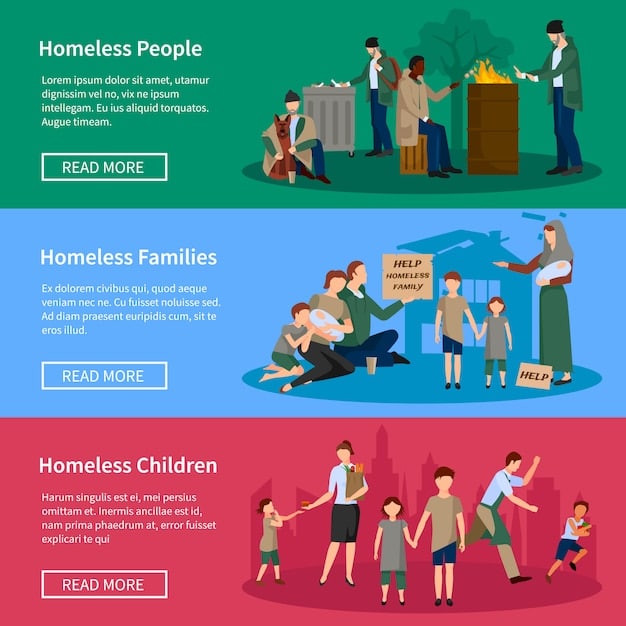Addiction Recovery: Weighing Financial Costs vs. Investment in Recovery 2025

The Financial Cost of Addiction vs. the Investment in Recovery: A 2025 Analysis reveals that while addiction can lead to significant financial burdens, investing in recovery offers a cost-effective solution with long-term physical, psychological, and economic benefits.
The escalating crisis of addiction in the US demands a thorough examination of its financial implications. This article, **The Financial Cost of Addiction vs. the Investment in Recovery: A 2025 Analysis**, aims to provide a balanced perspective, weighing the economic burdens against the value of investing in effective treatment and recovery programs.
Understanding the Economic Burden of Addiction
Addiction places a significant strain on individuals, families, and society as a whole. Understanding the broad economic impact is crucial for policymakers and healthcare professionals when addressing this pervasive issue.
Direct Costs Associated with Addiction
Direct costs are those immediately associated with addiction. They encompass healthcare expenditures and legal interventions, among others. Let’s explore some key aspects:
- Healthcare Expenses: These include costs for emergency room visits, hospital stays, medical treatments for addiction-related health issues, and mental health services.
- Legal and Criminal Justice Costs: Addiction often leads to involvement in the criminal justice system, resulting in expenses for arrests, trials, incarceration, and probation services.
- Treatment Costs: While an investment, the initial costs of treatment programs, therapy, and rehabilitation can be substantial, although they are generally less than the long-term costs of untreated addiction.
These direct costs paint a clear picture of the immediate financial implications of addiction, but the indirect costs also create significant economic challenges.

Direct costs highlight the immediate financial impacts of addiction, while indirect costs reflect long-term societal and economic consequences, affecting workforce participation, productivity, and overall societal well-being.
Indirect Economic Impacts: A Broader Perspective
Beyond direct costs, the economic impact of addiction extends to indirect costs, affecting productivity, employment, and social welfare programs. Analyzing these factors is vital for understanding the full economic burden.
Lost Productivity and Employment
Addiction significantly affects an individual’s ability to maintain employment and productivity. Here’s a detailed look:
- Absenteeism and Presenteeism: Individuals struggling with addiction are more likely to miss work or be less productive while at work due to substance use, health issues, or related problems.
- Job Loss: Addiction can lead to poor job performance, disciplinary actions, and eventual job loss, resulting in decreased income and economic instability.
- Reduced Earning Potential: The long-term effects of addiction can hinder career advancement and reduce an individual’s overall earning potential.
Moreover, addiction strains social welfare programs as affected individuals often require financial assistance and support services.
The consequences of addiction extend beyond the individual, creating financial burdens for families, communities, and government entities.
The Financial Toll on Families and Communities
Addiction’s impact extends beyond individual costs, affecting families and communities through various financial strains. Recognizing these effects is vital for comprehensive intervention and support.
Impact on Family Finances
Families often bear a significant financial burden when a member struggles with addiction:
- Increased Household Expenses: Families may incur additional costs for medical care, legal fees, and other addiction-related expenses.
- Lost Income: A family member’s addiction can lead to job loss or reduced work performance, decreasing household income.
- Financial Instability: The combined effect of increased expenses and lost income can destabilize the family’s financial situation, leading to debt and stress.
Communities also face financial challenges due to increased crime rates, reduced property values, and the strain on local resources.
The far-reaching economic consequences of addiction necessitate a proactive approach, focusing on prevention, treatment, and long-term recovery support.

Investing in Recovery: A Cost-Effective Solution
Investment in recovery is not merely an expenditure but a strategic allocation of resources with significant long-term benefits. Examining the cost-effectiveness of treatment programs is crucial.
Cost-Benefit Analysis of Treatment Programs
Treatment programs can seem expensive initially, but they offer substantial long-term cost savings:
- Reduced Healthcare Costs: Effective treatment can decrease the frequency and severity of addiction-related health issues, lowering overall healthcare expenses.
- Decreased Legal and Criminal Justice Costs: Recovery reduces the likelihood of involvement in the criminal justice system, saving on legal and incarceration costs.
- Increased Productivity and Employment: Successful treatment can help individuals regain employment and improve their work performance, contributing to economic stability.
Investing in prevention programs, early intervention, and comprehensive treatment yields substantial returns, not only in financial terms but also in improved quality of life and community well-being.
Prevention and early intervention strategies play a crucial role in reducing the long-term costs associated with addiction.
Prevention and Early Intervention Strategies
Investing in prevention and early intervention is a proactive approach to diminish the long-term financial and social costs of addiction. Effective strategies can make a significant difference.
Community-Based Prevention Programs
Community-based programs play a pivotal role in addiction prevention:
- Educational Initiatives: These programs provide information about the risks of substance use, promoting informed decision-making.
- Support Networks: Building strong community support systems offers individuals a safe environment and resources to avoid substance use.
- Early Screening and Intervention: Identifying at-risk individuals early allows for timely intervention and prevents the progression of addiction.
These strategies not only save costs but also foster healthier, more resilient communities and more independence.
Policy changes and systemic interventions are also essential for addressing the financial impact of addiction on a broader scale.
Policy Changes and Systemic Interventions
Well-designed policies and systemic interventions can significantly mitigate the financial burden of addiction. These measures create lasting and comprehensive solutions.
Insurance Coverage for Addiction Treatment
Expanding insurance coverage for addiction treatment can make it more accessible and affordable:
- Mandatory Coverage: Requiring insurance plans to cover addiction treatment ensures that individuals can access necessary services without prohibitive costs.
- Parity Laws: Enforcing parity laws ensures that mental health and addiction treatment are covered at the same level as physical health services.
- Public Funding: Allocating public funds to support addiction treatment programs can help bridge the gap for those who cannot afford private care.
These systemic changes can lead to significant reductions in healthcare costs, criminal justice expenses, and lost productivity, ultimately benefiting society as a whole.
| Key Point | Brief Description |
|---|---|
| 💰 Direct Costs | Healthcare, legal fees, and treatment expenses. |
| 📉 Indirect Costs | Lost productivity, unemployment, and social welfare. |
| 💊 Treatment Benefits | Reduces healthcare & legal costs, boosts productivity. |
| 🛡️ Prevention | Education, support, and early screening save long-term costs. |
Frequently Asked Questions
▼
The primary direct costs include healthcare expenses (emergency room visits, hospital stays), legal and criminal justice costs (arrests, trials), and treatment costs (rehabilitation programs, therapy).
▼
Addiction leads to absenteeism (missing work), presenteeism (reduced productivity at work), and job loss, resulting in decreased income and economic instability for individuals and their families.
▼
Investing in treatment reduces healthcare costs by decreasing addiction-related health issues, lowers legal costs by minimizing criminal behavior, and increases productivity by helping individuals regain employment.
▼
Prevention and early intervention strategies, such as community-based programs, educational initiatives, and early screening, can identify at-risk individuals and prevent the progression of addiction, saving long-term costs.
▼
Policy changes like mandatory insurance coverage for addiction treatment, parity laws ensuring equal coverage with physical health, and public funding for treatment programs can improve accessibility and affordability.
Conclusion
In conclusion, while the financial cost of addiction vs. the investment in recovery: a 2025 analysis reveals the substantial economic burdens imposed by addiction, it also highlights the significant financial and social benefits of investing in comprehensive treatment and prevention programs. By prioritizing prevention, treatment, and supportive policies, societies can mitigate these costs and foster healthier, more productive communities.





